
 |
A Very Brief History of Scotland - with a bias towards the Gaelic Highlands |
|
Scotland is a nation with a population of 5.4 million that is currently part of the United Kingdom. With approximately 30,000 square miles, covering the northern third of the island of Great Britain, it has a 96 mile border with England to the southeast and is otherwise surrounded by the Atlantic Ocean to the north and west, the North Sea to the northeast and the Irish Sea to the southwest. There are more than 790 islands; mainly within the Northern Isles of Orkney and Shetland and the Hebrides to the west. |
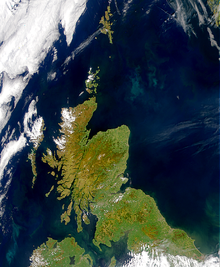 |
The first written reference to Scotland was in 320 BCE by Greek sailors who called the northern tip of Britain "Orcas", the source of the name of the Orkney islands. The first Roman invasion into Scotland occurred in 79 CE. Agricola established forts along the Highland boundary beginning at the Gask ridge to the west of Perth, but a few years afterwards, the Romans withdrew. Hadrian's Wall, which was built over a period of years beginning in 122 CE, became the northern border of the Roman Empire until the final Roman withdrawal from Britannia in 410 CE. The name “Scotland" comes from Scotti, the Latin name for raiders from Ireland. The Gaels named the land north of the Forth as Alba [pronounced A-la-pa] which is to this day, the Gaelic name for the country. The use of the words Scots and Scotland to encompass all of the land became common in the Late Middle Ages. |
|
After the Romans left Britannia, a number of warring kingdoms occupied the territory that would become Scotland: The adjoining map from an Irish perspective dates to the early 900s. Ireland, of course, is to the west and Innse Orc to the north. The peoples known to the Romans as Picts occupied the lands in the east and north. They were divided geographically into Alba, south of the Mounth and Cat to the North; Innse Gall, (the Hebrides) and Innse Orc (Orkney) were dominated by Viking settlers. In the early 11th century the islands became part of King Cnut's Danish empire; Strathclut, or Strathclyde, a Brythonic (Welsh speaking) zone from the Lennox in the north and stretching between the Clyde and the Solway, its principal centre was at Dùn Breatainn (Dumbarton); Anglo-Saxon Northumbria had overrun the Brythonic Kingdom of Manau Gododdin and occupied its capital Eidyn (Edinburgh) by 638 CE. Further Northumbrian expansion into Pictland was halted and reversed with the death of King Ecgfrith and destruction of his army at the Battle of Dun Nechtain in 685 CE. The Danes conquered the Kingdom of Northumbria in the late 9th century, but by 954. Danish weakness allowed the Scots King Indulf to retake Edinburgh and the Lothians. Airer-Gaidil – modern Argyll - which included Dàl Riata founded by settlers from Ireland, who brought the Gaelic language and culture with them.; There is a school of academic opinion that says that the settlement of Gaelic speaking peoples from Ireland in Dàl Riata was earlier and may have predated the Roman invasion. The mountainous spine of the Highlands made east-west travel difficult, whereas seaborne travel over the short distance to Ulster in the North of Ireland was much easier. However, the movement into Dàl Riata of a small elite group of Gaels led by Feargus mòr mac Erc in the 5th century CE was recorded in Irish annals and is usually taken to be the beginnings of Gaelic Scotland. |
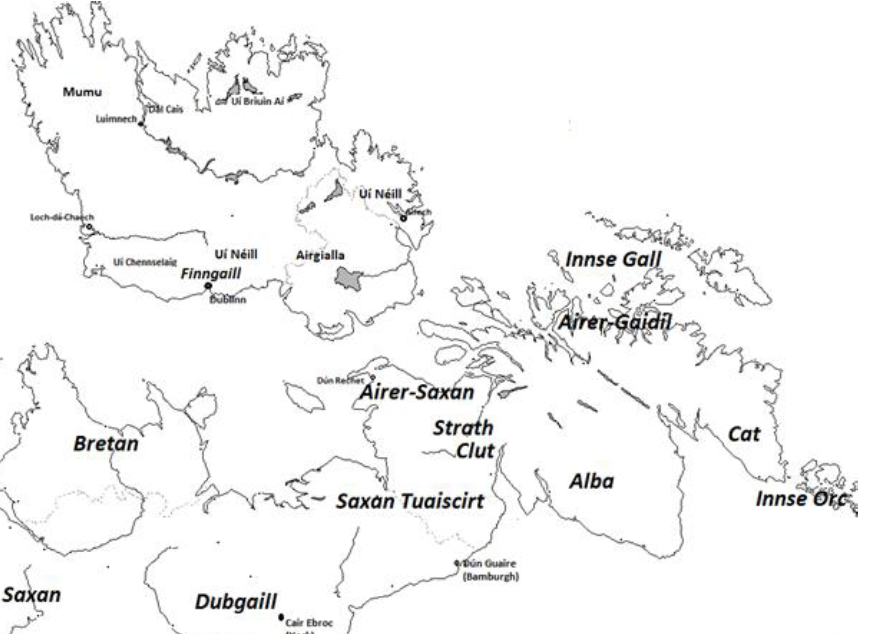 |
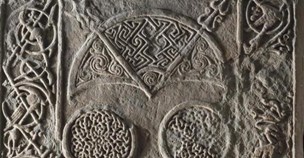 |
There has been much debate over the origin and language of the Picts. They have left a series of spectacular carved monuments, but since no written records in the Pictish language have survived, academics have assumed that they did not possess a literate culture. Until recently the academic consensus has been that the Picts were P-Celts, and spoke a Brythonic language related to Welsh. Recently it has been suggested that the Picts or Cruithne were related to the Èrainn in Ireland who preceded the coming of the Goidelic Celts by several thousand years and may have spoken a Hamito-Semitic language related to the Berbers of North Africa. |
|
Gaelic influence over Pictland and Northumbria was facilitated by Gaelic speaking Christian missionaries. Colm Cille, Saint Columba, who arrived in Iona around 563 CE was one of the best-known. Celtic monks trained in Iona christianised Pictland and the Northumbrian Angles. In 664 CE the Synod of Whitby determined that Northumbria would henceforth adopt Roman practice in place of the Ionan tradition. But the Celtic form of Christianity only ended in Scotland itself when Margaret, the Saxon who became the second wife of King Malcolm Canmore in 1070, introduced Roman priests to the court. Margaret was later canonized by the Pope in Rome. Viking raids from Scandinavia began in the late eighth century. After a series of brutal raids, well-documented by the monks, the Norse and Danes began to settle. They would dominate many areas in the Hebrides, along the west and north coasts of the mainland, and especially in the Northern Isles where Old Norse entirely displaced the earlier culture. By the early 11th century, King Cnut's Danish empire encompassed large areas of England, all of the Scottish islands and the north mainland as well as much of Ireland. In the ninth century, the Gaelic and Pictish kingdoms were both ruled by Cinàed mac Ailpìn (Kenneth I). Monastic annals report that the two peoples merged, perhaps as a result of Viking pressure from the east and west. A number of Highland clans, including Clan Gregor, claim to descend from Cinàed mac Ailpìn. Indeed, the subsequent line of monarchs of the United Kingdom can all trace their lineage back to the royal dynasty which Cinàed established. By the end of the tenth century, the language of the consolidated kingdom had become Gaelic. From its base in eastern Scotland north of the River Forth, the Kingdom expanded southwards, into the former Northumbrian lands and the Kingdom of Strathclyde. Around the turn of the millennium, the first urban settlements began to be established. |
A Nation State: By the late eleventh and early twelfth centuries, with much of Scotland under the control of a single ruler, a nation state in the modern sense first emerged, as did a national consciousness. The domination of Gaelic began to diminish during the reign of David I (1124–53), when many Norman knights were introduced from England and granted lands under feudal tenure. David I and his successors centralized royal power and united mainland Scotland, increasing their control of peripheral regions such as Moray, Galloway and Caithness. The Norse kingdom of the Hebrides became part of Scotland following the Battle of Largs in 1263. Feudalism consolidated, with both Anglo-Norman incomers and native Gaelic chieftains being granted land in exchange for oaths of fealty to the king. There were repeated attempts by the Norman kings of England to subjugate Scotland which failed. The death of Alexander III in March 1286 broke the line of succession of Scotland's kings. Edward I of England was invited to arbitrate between competitors for the Scottish crown, particularly the claimants of the Bruce and Comyn families, both of whom descended in the female line from David I. Edward first demanded feudal oaths of fealty to him from Scotland’s nobles. Edward awarded the throne to John Balliol in 1292, but when Edward ordered Balliol in 1295 to send a Scots force to join his army against the French, Balliol rebelled and instead Scotland and France sealed a treaty on 23 October 1295, which would later become known as the Auld Alliance and last until the 16th century. Edward brought his army north, deposed Balliol and declared that Scotland was now a part of his realm. Andrew Moray and William Wallace were appointed Guardians of Scotland and raised an army against the English occupation. After success in the Battle of Stirling Bridge (where Moray was killed), Edward himself brought his army north once more and defeated Wallace at the Battle of Falkirk. Wallace was subsequently betrayed to the English, taken to London and brutally executed. |
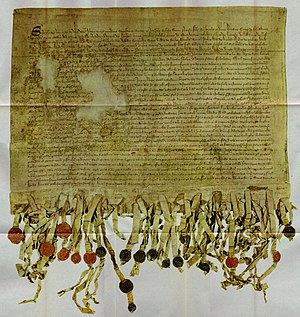 |
In 1306, Robert Bruce, the grandson of Bruce the competitor, rebelled against Edward and was crowned King Robert I at Scone, near Perth. Years of vicious conflict culminated in a spectacular victory over a numerically superior English army at the Battle of Bannockburn in 1314. But Edward II of England refused to concede Scottish Independence and launched a diplomatic campaign for the approval of his claims of superiority over Scotland with the Papacy. King Robert and his nobles sent a letter to the Pope, in 1320. The letter, which has become known as the Declaration of Arbroath, is today regarded as the world's first documented declaration of independence. It won the approval of Pope John XXII and led to the Treaty of Northampton in 1328 by which Edward II of England recognized the independence of Scotland. |
|
Robert Bruce’s son, David succeeded him as king in 1329, but as he had no sons, the son of his sister Marjory and Walter the High Steward, came to the throne as Robert II in 1371, thus establishing the house of Stewart which would rule Scotland for the remainder of the Middle Ages. The country experienced greater prosperity from the end of the 14th century through the Scottish Renaissance to the Reformation in 1560, In 1468, King Christian I of Denmark pawned the islands of Orkney and Shetland to Scotland in lieu of a dowry for the marriage of his daughter to King James III. The islands were subsequently annexed to Scotland as the dowry was never paid. By about the year 1450, a northern dialect of Anglo-Saxon had became known as ‘Scots’ and was widely used across Lowlands. The Scots language began to be used in place of Latin for official documents after 1462. Highlanders continued to speak Gaelic, which the Lowlanders, henceforward, would refer to as Erse or Irish. In earlier times, 'Scots' had meant Gaelic. The Highland zone was dominated culturally and militarily by the MacDonald Lordship of the Isles, until in 1493 when James IV, the last monarch able to speak Gaelic, formally abolished the Lordship. However, the Stewarts failed to establish adequate order in the Highlands to take the place of the Lordship, thus leading to a culture of raiding and violence. The vehemently anti-Gaelic James VI described Highland clans such as the MacGregors and MacLeods in Lewis as "maist barbarous" and issued orders that they "be exterminat and ruttit out". Many Highland chiefs maintained their personal militia of trained fighting men known as gallowglasses – gall òglaich. During times of relative local peace at home, these men often became involved on one side or the other fighting in Ireland. |
|
In 1609 James VI promulgated the Statutes of Iona by which Highland chiefs were ordered to adopt the Reformed Religion, use Scots instead of Gaelic and have their heirs educated in the Lowlands. The chiefs were also ordered not to host sorners and beggars - which meant their armed retainers and traditional itinerant Gaelic bards and musicians. Despite the statutes, distinctive Highland society and culture only finally ended following the defeat of the last Jacobite Rising in 1746. Thereafter, Highland chiefs were encouraged to live in the Lowlands and exploit the lands of their erstwhile clansmen for their personal enrichment, while their impoverished people were encouraged to leave the Highlands to fight on behalf of and populate the growing British Empire. |
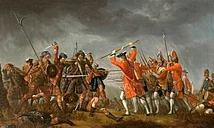 |
|
Religion: The Catholic church in Scotland was abolished by Acts of Parliament in the Scottish Reformation of 1560. A Presbyterian (Calvinist) form of church government was introduced despite the opposition of Queen Mary. During the following 130 years, the Presbyterians struggled against the Episcopal system favoured by successive rulers. The National Covenant of 1638 marked an organised rejection of the liturgical practices and Episcopal church government demanded by King Charles I in London. Debate turned to violent opposition by the armies of the Covenant in alliance with English Puritans. The Presbyterian church was strongest in the Lowlands and especially the South-West. In the Highland zone, most chiefs, with some notable exceptions such as the Campbells, tended to prefer the Episcopal church and pockets of Catholicism also survived. In 1644/45 James Graham Marquis of Montrose led a Highland army, bolstered by Irish Catholics led by Alasdair MacColla MacDonald, which won successive battles for the King against Covenanting armies until his ultimate defeat at Philiphaugh. In the Revolution Settlement of 1690, following the coronation of William and Mary, the Presbyterian church became the Established Church of Scotland and many 'non-juring' Episcopal ministers were ejected from their parishes. The Presbyterian establishment obtained a series of safeguards of their position in exchange for supporting the Union of 1707. In successive Jacobite Risings, in 1689, 1715, 1719 and 1745-46, the exiled Stewarts drew much of their support from the Highlands as well as the Episcopal-leaning lairds and lords along the east coast against the Lowland Presbyterian establishment which largely supported the Hanoverian Government. The Scottish branch of the SPCK (Society for Propagating Christian Knowledge) was founded in Edinburgh in 1709. For much of the 18th century its mission was to establish and manage schools teaching English in the Highlands, in order to secure both the 1690 Presbyterian settlement of the Church of Scotland, and the Hanoverian succession. The English language and ‘Reformed Protestantism’ were to be the cornerstones of a new ‘North British’ identity. The SSPCK made use of Lowland anti-Gaelic feeling to support its activities. By the 19th century a strongly evangelical presbyterianism had taken hold across the Highlands, coupled with the effect of the Patronage Act of 1712 which gave the heritors (landowners) the right to appoint ministers. During the Clearances, many Highland tenants would be convinced by the church ministers that their ejection from their farms and expulsion from Scotland had been the consequence of their sins rather than due to the economic interests of the landlords. |
|
Union with England: The sovereign Kingdom of Scotland continued until 1707. James Stuart, VI of Scotland, inherited the kingdoms of England and Ireland in 1603 and formed a personal royal union of the three kingdoms, but he failed in his ambition to incorporate them into a single state. James was succeeded by Charles I whose stupidity and intransigence led to civil war and ultimately the king's execution in 1649 by Oliver Cromwell. Scotland crowned Charles II as king but his Scots army of the Covenant was defeated at Worcester in 1651 and the king fled to Holland. Between 1651 and 1660 Scotland was incorporated in Cromwell's Commonwealth and English garrisons were placed in strategic locations. The Restoration of Charles II in 1660 ended the English occupation. The government of Scotland was vested in noble committees with the occasional presence of the King's brother James, who would succeed as James VII and II in 1685. The openly catholic King James was deposed in 1688 and replaced by his sister Mary and her husband William of Orange. With an absentee monarch, the devastating religious Wars of the Three Kingdoms in the mid 17th century, the disaster of “King Billy’s ill years” (1695-1699) and the failure of the Darien colony in 1700, some of the Scottish nobility perceived benefits to themselves from closer union. Thus, despite much opposition from the people, on 1st May 1707, Scotland entered into a political incorporating union with England to create the new Kingdom of Great Britain. In 1801, the Kingdom of Great Britain entered into a political union with the Kingdom of Ireland to create the United Kingdom of Great Britain and Ireland. In 1922, the Southern counties of Ireland, finally succeeded in seceding as the Irish Free State from the United Kingdom, leading to the latter being renamed the United Kingdom of Great Britain and Northern Ireland. |
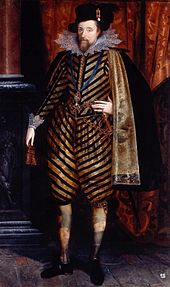 |
Modern Scotland: From the mid 18th century until the late 19th century, Scotland experienced unprecedented change, with industrialisation and urbanisation driven by the profits of empire in which Scotland benefitted to a degree greater than its population share of the United Kingdom. Scots migrated to and prospered in almost every corner of the world. The consequence of this exodus can be seen in the change in the relative populations of Scotland and England, from approximately one fifth in 1707 to one twelfth today. Sir Walter Scott, in 1822, almost single-handedly created an ersatz Highland culture with the visit of George IV to Edinburgh. A new tartan industry was born and "clan tartans" were designed for gentlemen of any and every Scottish name - many of whom in previous generations would not have been seen dead in a kilt. Highland Societies were founded in London and Edinburgh for gentlemen chiefs, fresh from evicting their folk, to meet and invent new traditions of Highlandism. Dating from the economic "long depression" from 1873 to 1896, a renewed interest in an independent Scotland emerged, as the perceived benefits to Scotland of the Union declined. The increasing centralisation of administration from London during the 20th century led to the foundation of the Scottish National Party in 1934, but it wasn’t until the late 1960s that the party began to achieve electoral success. A devolved Scottish Parliament was re-established in 1999, following a referendum. Today, the SNP are the ruling party in the Scottish Parliament and have the majority of Scottish seats in the Westminster Parliament. At the time of writing, a series of opinion polls have shown an increasing majority favouring complete independence. |